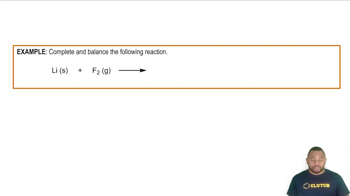There are many Lewis structures you could draw for sulfuric acid, H2SO4 (each H is bonded to an O). (b) What Lewis structure(s) would you draw to minimize formal charge?
Consider the lattice energies of the following Group 2A compounds: BeH2, 3205 kJ/mol; MgH2, 2791 kJ/mol; CaH2, 2410 kJ/mol; SrH2, 2250 kJ/mol; BaH2, 2121 kJ/mol. (a) What is the oxidation number of H in these compounds?
 Verified step by step guidance
Verified step by step guidance
Verified Solution
Key Concepts
Oxidation Number

Group 2A Elements

Hydrides

Some chemists believe that satisfaction of the octet rule should be the top criterion for choosing the dominant Lewis structure of a molecule or ion. Other chemists believe that achieving the best formal charges should be the top criterion. Consider the dihydrogen phosphate ion, H2PO4-, in which the H atoms are bonded to O atoms. (b) What is the predicted dominant Lewis structure if achieving the best formal charges is the top criterion?
State whether each of these statements is true or false. e. Energy is stored in chemical bonds.
The ionic compound CaO crystallizes with the same structure as sodium chloride (Figure 8.3). (a) In this structure, how many O2- are in contact with each Ca2+ ion (Hint: Remember the pattern of ions shown in Figure 8.3 repeats over and over again in all three directions.)
Construct a Born–Haber cycle for the formation of the hypothetical compound NaCl2, where the sodium ion has a 2+ charge (the second ionization energy for sodium is given in Table 7.2). (a) How large would the lattice energy need to be for the formation of NaCl2 to be exothermic?
Consider the collection of nonmetallic elements O, P, Te, I, and B. (a) Which two would form the most polar single bond?
